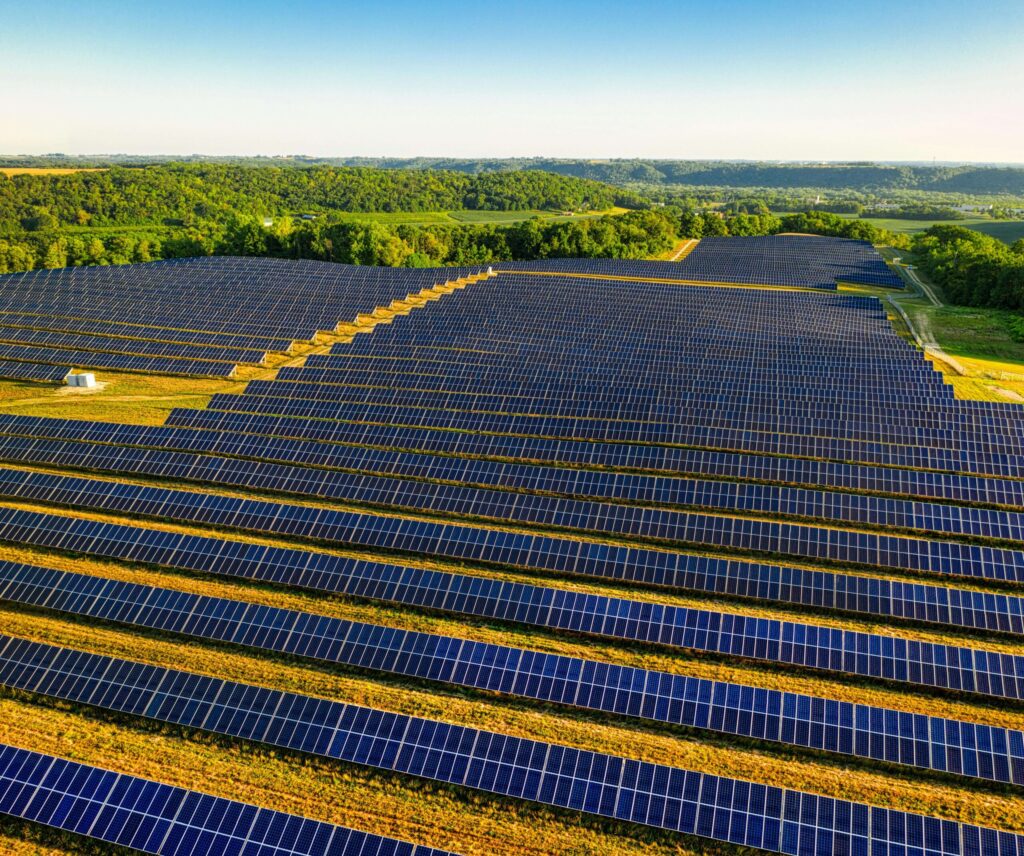As the world increasingly uses renewable energy, solar power is becoming a central focus in the United States. Solar energy is more than just a trend, it’s a transformative force reshaping how the nation produces electricity. Yet, many people still Wonder, “What is the process of solar energy?” and “Where does the process of solar energy begin?” This comprehensive guide will discuss the process of solar energy, explaining the process of converting solar energy to electricity, and discussing the science, technology, and practical applications that establish solar power as a key element of America’s renewable energy future.
The Basics: What is Solar Energy?
Solar energy is the radiant light and heat emitted by the sun that we capture using different technologies to produce electricity, heat water, or provide illumination. But what exactly is the process of solar energy that contributes to its effectiveness? The answer is found in the photovoltaic (PV) effect, a phenomenon first identified in 1839 by French physicist Alexandre-Edmond Becquerel.
Understanding the Photovoltaic Effect
The photovoltaic effect underpins the process of converting solar energy to electricity. When sunlight hits a solar panel, it interacts with photovoltaic cells composed of semiconductors such as silicon. This interaction cause electrons from their atoms, generating a flow of electricity. This electric flow is then collected and channeled through wires for use as electrical power.
Solar Panels: The Heart of Solar Energy Conversion
Solar panels, which consist of numerous PV cells, are at the core of the process of solar energy conversion. These cells are arranged in a grid-like pattern and work in unison to capture sunlight and convert it into direct current (DC) electricity. In the U.S., solar panels are commonly installed on rooftops, in large solar farms, and increasingly on parking structures and other urban spaces.
The Science Behind Solar Energy Conversion
Knowing the science behind the process of solar energy is essential for appreciating its full potential. Here’s a breakdown of the key steps involved in converting sunlight into electricity:
1. Absorption of Sunlight
The initial step in the process of solar energy conversion involves the absorption of sunlight by the photovoltaic (PV) cells within a solar panel. These cells, constructed from semiconductor materials such as silicon, capture photons from sunlight. When these photons strike the PV cells, they excite electrons, thereby creating an electric current.
2. Conversion to Direct Current (DC)
Once the electrons are excited and start moving, they generate an electric current known as direct current (DC). However, since most U.S. homes and businesses operate on alternating current (AC), not DC, the next step involves converting this current.
3. Inversion to Alternating Current (AC)
To make the electricity produced by solar panels suitable for use in homes and businesses, it must be converted from DC to AC. This transformation is accomplished by a device known as an inverter. The inverter takes the DC electricity generated by the solar panels and converts it into AC electricity, which can then be used to power electrical appliances, lighting, and other devices.
4. Distribution and Use
The final step in the process of solar energy is the distribution and use of the generated electricity. Once converted to AC, the electricity is sent to an electrical panel and distributed throughout the home or business. Any excess energy can be fed back into the grid, stored in batteries for later use, or sold back to the utility company.
The Efficiency and Effectiveness of Solar Energy
In the U.S., solar energy stands out as both an environmentally friendly and highly efficient option. Recent advancements in solar technology have markedly improved the efficiency of solar panels, enabling them to convert a greater amount of sunlight into electricity. The average efficiency of modern solar panels ranges from 15% to 22%, with some latest models achieving even higher levels.
Factors Influencing Solar Panel Efficiency
A number of factors can impact how efficiently solar panels perform, such as:
- Location: Solar panels are most effective in areas with abundant sunlight, such as the southwestern U.S.
- Angle of Installation: The angle at which panels are installed can affect how much sunlight they capture.
- Temperature: Higher temperatures can reduce the efficiency of PV cells, though new technologies are improving heat tolerance.
- Maintenance: Regular cleaning and maintenance ensure that panels operate at peak efficiency.
Real-World Application: A Case Study from the U.S.
To illustrate the real-world application of the process of solar energy in the United States, let’s look at the example of a significant solar power project in the country.
The Ivanpah Solar Electric Generating System
The Ivanpah Solar Electric Generating System, situated in California’s Mojave Desert, is among the largest solar thermal power plants globally. This facility uses mirrors to concentrate sunlight onto receivers mounted on power towers. The concentrated heat generates steam that drives turbines to produce electricity.
Ivanpah has a capacity of up to 392 megawatts (MW), sufficient to power 140,000 homes each year. This enormous solar plant demonstrates the potential of solar energy to address large-scale electricity needs while significantly cutting carbon emissions. It also illustrates how the process of solar energy can be implemented on a grand scale to support national energy requirements.
The Environmental Impact of Solar Energy
One of the most compelling reasons to invest in solar energy in the United States is its minimal environmental impact. Unlike fossil fuels, which release harmful pollutants and contribute to climate change, solar energy is clean and renewable. By comprehending the process of solar energy, we can appreciate how it significantly contributes to lowering the country’s carbon footprint.
Reducing Greenhouse Gas Emissions
Using solar energy greatly cuts down on greenhouse gas emissions. According to the U.S. Environmental Protection Agency (EPA), the average residential solar panel system can offset approximately 3 to 4 tons of carbon dioxide annually, equivalent to planting over 100 trees each year.
Conserving Water Resources
Conventional power plants, particularly those that use coal, natural gas, or nuclear energy, need large quantities of water for cooling. In contrast, solar power generation requires little to no water, making it a more sustainable option, particularly in water-scarce regions of the U.S.
Land Use Considerations
Although solar farms need land for installation, they can often be placed on less productive areas, like deserts or old industrial sites. Moreover, new approaches such as floating solar panels on reservoirs or combining solar panels with agricultural land (agrivoltaics) are developing solutions that improve land use efficiency.
Overcoming Challenges in Solar Energy Adoption
Despite the many benefits of solar energy, there are challenges to its widespread adoption in the U.S. These include high initial costs, the need for large installation spaces, and variability in energy production due to weather conditions. However, technological advancements and supportive policies are helping to overcome these hurdles.
Financial Incentives and Cost Reduction
One of the main obstacles to solar energy adoption in the U.S. has been the initial cost of installation. Nonetheless, the price of solar panels has decreased by over 80% in the past decade, making solar energy more accessible to both homeowners and businesses. Additionally, government incentives, tax credits, and financing options can further decrease the financial burden.
- Federal Investment Tax Credit (ITC): The ITC allows homeowners and businesses to deduct 26% of the cost of installing a solar energy system from their federal taxes.
- State and Local Incentives: Many states offer additional incentives, such as rebates, property tax exemptions, and net metering policies that allow solar panel owners to sell excess electricity back to the grid.
Energy Storage Solutions
The variability in solar energy production presents another challenge, as solar panels produce electricity only when sunlight is available. To address this issue, energy storage systems like batteries are becoming increasingly crucial. These systems store excess energy generated during sunny periods and provide it when sunlight is absent, ensuring a stable and reliable power supply
Integration with the Grid
Integrating solar energy into the existing power grid is vital for balancing supply and demand. To increase the efficiency and reliability of this integration, smart grid technologies and advanced inverters are being developed. These innovations facilitate a smoother transition to renewable energy sources by improving the management and distribution of solar power.
The Future of Solar Energy in the United States
As we look to the future, the role of solar energy in the U.S. energy mix is expected to grow significantly. The U.S. Department of Energy (DOE) projects that solar power could account for 40% of the nation’s electricity by 2035, driven by declining costs and supportive policies.
Innovations on the Horizon
Several promising innovations are set to improve the process of solar energy conversion in the U.S.:
- Perovskite Solar Cells: A new type of solar cell material that promises higher efficiency and lower production costs.
- Bifacial Panels: Solar panels that can capture sunlight on both sides, increasing energy output.
- Solar Skin Design: Aesthetic solar panels that blend seamlessly with building designs, encouraging wider adoption in urban areas.
Case Study: Solar Energy and Rural Electrification in the U.S.
Solar energy is also revolutionizing rural electrification in the United States. In areas where traditional power infrastructure is limited, off-grid solar systems offer a dependable and cost-effective solution for accessing electricity.
For instance, in the Appalachian region, several initiatives have been launched to introduce solar power to rural communities. These projects not only deliver essential electricity but also generate jobs and boost local economies. They illustrate how the process of solar energy can extend its benefits beyond mere power generation, demonstrating what is the process of solar energy and how it can contribute significantly to local development.
Conclusion
The United States is leading a global transition towards renewable energy, with solar power being a central component. By knowing the process of solar energy—from the photovoltaic effect to its real-world applications—we gain a deeper understanding of how this clean, abundant resource is transforming the American energy market. As technology progresses and costs continue to decrease, solar energy will increasingly play a crucial role in powering the nation while mitigating environmental impacts. Whether through rooftop panels, expansive solar farms, or advanced technologies, the future of solar energy in the U.S. is indeed promising.

